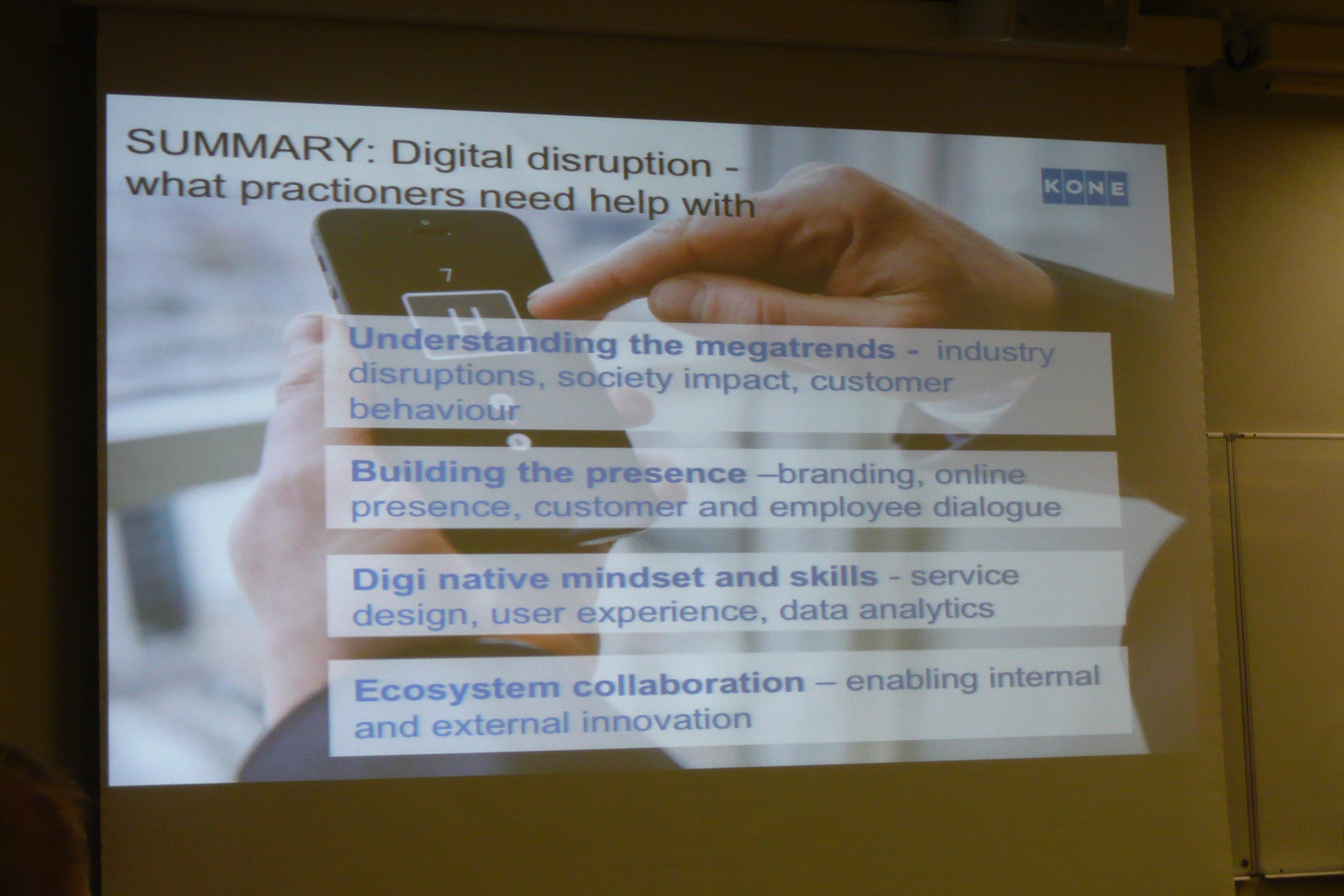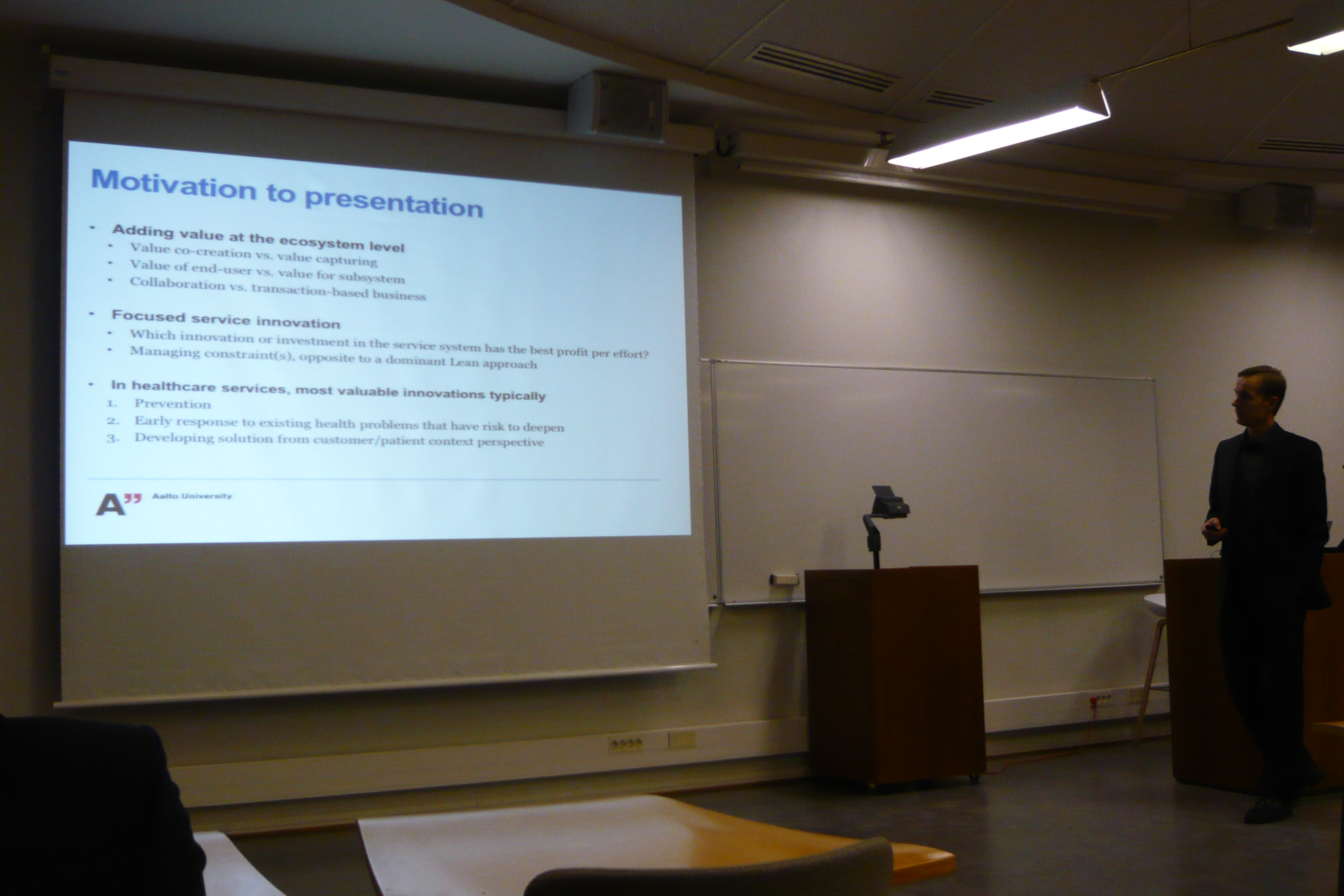I had a great time at the Aalto Service Factory (ASF) that held its final event to celebrate the six years of its existence. To those who don’t know ASF, it is an open collaboration platform for service research and education atthe Aalto University.
First we learnt about the ASF network and its activities from Virpi Tuunainen and Minna-Kaarina Forssén, who held the opening presentations. It was interesting for me to find out what everything ASF does while concentrating on three target groups – researchers and teachers, students and practitioners. It organizes research presentation events called ASF Meets & Talks and events for sharing research that go by the name of Networking Evening Seminars. It has the 300 member strong ASF club, it publishes the quarterly ASF Newsletter with topics on service domain news and the monthly ASF blog with practice-oriented articles. Furthermore, ASF hosts the Researchers´ Breakfasts and another breakfast event called Early Birds that aim to build research consortiums.

ASF is also very agile in students activities. There is the yearly seminar on service industry job opportunities Young Student – Go services! and Aalto Introduction to Services organise every year. Mrs. Forssén pointed out that ASF is now finishing but the use of its good practices will continue at the Finnish Service Alliance. Check it out at http://www.servicealliance.fi.
A GLOBAL LEADER IN THE ESCALATOR AND ELEVATOR INDUSTRY

The keynote speaker was KONE’s Senior Vice President for Development, Digitalisation Strategy, and Service Business, the amazing Kati Hagros who was previously KONE´s CIO. She talked about Digitalization in industrial services context. She emphasized the role of services in KONE’s portfolio. Already in the 1970´s, half of the company´s revenue came from services. Mrs. Hagros mentioned that KONE combines business, technology and services to create a superior customer experience.
PEOPLE FLOW INTELLIGENCE
Mrs. Hagros spoke about the Destination control system (DCS) which provides clear guidance for passengers, assigning them to the most appropriate elevator according to their destination floor. It reduces travel times and eliminates overcrowding and unnecessary stops. Watch this video on KONE’s world class People Flow Intelligence solutions featuring KONE´s Polaris destination control system. It is a way how to avoid the morning rush. The system recognizes where the person is headed, knows which rooms are free and where different meetings take place etc.
In her presentation, Mrs. Hagros pointed out that it is quite rare that a company would stay focused in the same industry for 105 years, like Konehas done in the escalator and elevator business. KONE operates in over 50 countries and has a service business intensive base in the sense of the amount of employees. KONE is also the number 1 in the world in making new elevators. KONE moves 1,5 million people at any given moment of time in elevators and on escalators which is 1,5 times the number of people travelling by airplane. KONE had a digital system in use already in the 70´s and the ability to remotely control lifts has existed for the past 20 years. Mrs. Hagros updated us on how much more demanding users are nowadays compared to the past in the level of irritation when waiting for the lift to arrive.

DIGITAL DISRUPTION
In the future the digital activities of KONE will focus on the following:
- filed operation productivity
- sales management efficiency
- new services and solutions
- new business models
Mrs. Hagros stated that digital tools are mandatory. When working as the CIO for KONE she faced an issue: completing a business road map takes 3-5 years but by the time the end is reached, the digital tools are too old. Other issues are that the life cycle of a building is very long, during which owners of the buildings change, there is no negotiating with the architects who plan the buildings into which KONE installs elevators… Mrs. Hagros said that digital disruption is not easy. KONE´s sales department isn´t excited about the digital world – clients don´t have to call them any more to buy certain services or spare parts, elevators are remotely controlled and that is the good business versus digital disruption dilemma. While it is enough to develop a new elevator every 10 – 15 years, an app has to be updated many times a year.

Mrs. Hagros finished her very interesting presentation with a picture of the future Kingdom Tower. It will be the world’s tallest building once completed in 2018 and is expected to rise to a height of more than one kilometer, fully equipped by KONE including 57 elevators and 8 escalators with the newest digital solutions manufactured and installed by KONE.

HUUTO.NET CASE
The next presentation which really got me interested was titled Is openness always a good thing in digital services? Heikki Lempinen of Sanoma, the company that runs http://www.huuto.net, came to share with us what happens when things go wrong. The on-line auction site Huuto.net was established in 1999 and at the height of its popularity had 400 000 visitors per week and 1,7 million registered users. When they introduced an API, with which users could create Excel-type tables and, for example, place hundreds of collectors´stamps on the market place with a single click. The result was that a handful of sellers filled the site with thousands of irrelevant products that would have an extremely low turnover. It was hard to find relevant products in the flooded categories which was, of course bad for business.

THE OMASAIRAALA CASE
The last presentation I´d like to share with you was delivered by Assistant Professor Antti Peltokorpi of Aalto University. He told us about two cases, the first of them being Pohjola Omasairaala. Omasairaala engaged its doctors in a customer value-centric culture and made them focus on two KPI (Key performance indicators):
- The time required to get well in order to be able to return to work
- NPS (Net Promoter Score) – a customer loyalty metric
Omasairaala employers relied rather on conservative procedures like rehabilitation than surgeries. Patients were operated only if it speeded up returning to work, even though the company could have charged more for surgery than for conservative treatment. They recruited Care Masters and Work Masters to improve administrative processes making Omasairaala “more of a social office than a hospital”. Capacity utilization wasn´t considered as important as customer-oriented innovations. In the second year, these innovations started to show results. Omasairaala´s patients had up to 30% shorter sick leaves compared to other hospitals and 98% of customers would have recommended the service to others.
Mr. Peltokorpi mentioned that the biggest challenge Omasairaala faced was to pursuade the doctors to change their way of thinking, in other words to implement a medical approach that is less based on surgeries.

Written by Jana Arhio, Laurea

Leave a comment